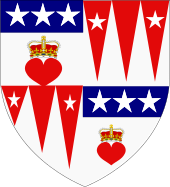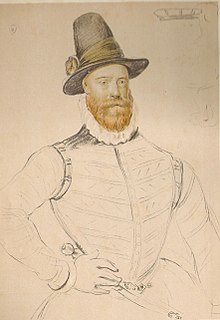James Douglas, 4th Earl of Morton
James Douglas, 4th Earl of Morton (* 1525 - † June 2, 1581 in Edinburgh ) came from the influential and extensive Douglas clan in Scotland . He was involved in the tragic fate of Queen Maria Stuart , whose overthrow he helped, and led from 1571 to 1578 for her underage son Jacob VI. the affairs of state. In 1581 he was executed.
Life
His parents were Sir George Douglas of Pittendriech (a younger brother of Archibald Douglas, 6th Earl of Angus ) and Elisabeth Douglas. By 1543 at the latest, James Douglas was married to Elisabeth Douglas, daughter of James Douglas, 3rd Earl of Morton . In 1553 James Douglas succeeded his father-in-law as Earl of Morton and also inherited his castles Dalkeith House in Midlothian and Aberdour Castle in Fife.
In the spring of 1558, Morton joined the Protestant Lords of the Congregation . He participated in 1559/60 in the revolt of the Lords against the regent Marie de Guise . Morton was a member of the Council of State from 1561, and in 1562 he was appointed Lord Chancellor . Morton assisted Mary Stuart in August and September 1565 in suppressing the rebellion of her half-brother James Stewart, 1st Earl of Moray .
The murder of Rizzio
The Italian musician David Rizzio had been in the favor of Maria Stuart since October 1565 and gained considerable influence on Scottish politics through his office as secretary to the Queen. Maria Stuart entrusted Rizzio with the conduct of her correspondence with the Pope and with France . As a result, many Scottish lords, including Morton, feared a loss of personal power and a return to pro-Catholic politics.
On March 2, 1566, William Maitland of Lethington , the Earl of Moray and Lord Henry Darnley signed a treaty in Newcastle , allowing the exiles around Moray to return to Scotland and confirming Darnley's co-kingship. It was also decided to maintain the Protestant religion in Scotland. The content of the contract was communicated to the Queen of England. The murder of Rizzio was not recorded in writing. The later murderers of Rizzios like Douglas, his half-brother George Douglas the Postulate and Lord Ruthven (1520–1566) and Lord Lindsay († 1589), whose wives came from the Douglas clan, took part in the contract negotiations. It can be assumed that the murder of Rizzio in Newcastle was discussed and decided.
On March 9, 1566, Maria hosted a small private dinner at Holyrood Castle. In the late evening hours Douglas and other nobles and their armed entourage broke into the private quarters of the queen, who was six months pregnant. The intruders lunged at Rizzio, dragged him into the next room and stabbed him there. Mary Queen of Scots became the prisoner of Douglas, but she won Darnley over. With his help, Maria Stuart was able to free herself from captivity on the night of March 11th to 12th, 1566. A few hours later she initiated the pursuit of Rizzio's murderers. Douglas fled and reached safe England on March 17, 1566.
The Darnley Assassination
Mary Stuart pardoned Douglas on December 24, 1566, and returned to Scotland a short time later. There are different statements from those involved about the preparations for the murder of Darnley . The main actors Bothwell and Morton later accused each other of planning and carrying out the Darnley murder. Morton confessed shortly before his execution that the Earl of Bothwell had suggested that he assassinate Darnley. Morton is said to have refused this, as he did not want to fall from grace again after his pardon. As a precaution, he sent his relative Archibald Douglas to Edinburgh to inform Mary Stuart. She is said to have replied in horror: "Tell the Earl of Morton that the Queen does not wish to speak about this question." By February 7, 1567 at the latest, Morton was informed of the ongoing preparations for the planned assassination attempt on Darnley. On February 10, 1567, Darnley was killed at Kirk o'Field Castle. Bothwell was suspected of being an assassin and put on trial soon after. On April 12, 1567 the trial took place, in which Morton did not participate. Bothwell was acquitted. In late April 1567, Morton undertook to recommend Bothwell as the Queen's husband. But already at the beginning of May 1567 Morton, the Earl of Argyll and the Earl of Atholl formed an alliance, which turned against an increase in rank of Bothwell.
The fall of Maria Stuart
On June 15, 1567, the rebels, led by Morton, moved from Edinburgh towards Musselburgh. A few hours later the royal troops, under Bothwell's command, took up their position at Carberry Hill, some eight miles east of Edinburgh. Bothwell challenged Morton to a personal duel. Morton refused and instructed Lindsay to negotiate with Bothwell. Due to his low troop strength, Bothwell avoided an open battle, he submitted to Morton and allowed himself to be granted safe conduct. Morton took the Queen prisoner and had her arrested at Loch Leven Castle . A follower of Bothwell's told Morton where the cassette letters had been hidden after the torture had been applied. Morton kept this since June 20, 1567. Mary Stuart abdicated on July 24, 1567 under pressure in captivity, in favor of her one-year-old son James, James VI. Mary's half-brother James Stewart, 1st Earl of Moray, took over the reign . In May 1568 the former queen managed to escape from Lochleven and to bundle her followers for the last time. Moray, Kirkcaldy and Morton immediately led their troops against Mary Queen of Scots and defeated them at the Battle of Langside on May 13, 1568. Mary Queen of Scots fled to England. From October 1568 a show trial took place, first in York and later in Westminster, with the aim of proving Maria Stuart's guilt in the murder of Darnley. Morton presented the cassette letters there as proof of her guilt .
Reign and death
After the assassination of the regent Moray on January 23, 1570, war broke out in Scotland between the party of the king (James VI.) And the party of the queen (Maria Stuart). From August 1571, John Erskine, Earl of Mar , acted as regent for the minor king. In fact, Morton ruled. After the Earl of Mar's death on October 28, 1572, Morton also officially became regent of Scotland. With the help of an English force, Morton defeated the last supporters of Maria Stuart, who were desperate to defend Edinburgh Castle. In May 1573 the followers of Mary surrendered, their leaders William Maitland of Lethington and William Kirkcaldy of Grange were executed in August 1573 at the instigation of Morton.
Morton proved a capable but brutal regent. Under his reign the political and church administration was reorganized. As regent, Morton secured the pro-English and Protestant rule desired by Elizabeth I. Political and personal opponents and their families were ruthlessly expropriated, persecuted, imprisoned or hanged.
Morton had to resign as regent in 1578. The twelve year old Jacob VI. was formally declared king. In 1579 Esmé Stuart , Sieur d'Aubigny, came from France , Earl of Lennox since 1580, who, with the support of Captain James Stewart, from 1580 to 1585 Earl of Arran, gained control of the king and kingdom . Morton was arrested in 1580 because of his involvement in the murder of Darnley sentenced to death , and on 2 June 1581, despite English protests executed .
The heirs

John Maxwell, 7th Lord Maxwell (1553–1593), a grandson of the 3rd Earl of Morton, inherited Morton's title and property. In 1585 this succession was revoked and Archibald Douglas, 8th Earl of Angus (1555–1588), became 5th Earl of Morton. William Douglas of Lochleven (1539 / 40-1606), son of Robert Douglas of Lochleven and Margaret Erskine , was 6th Earl of Morton.
literature
- Antonia Fraser : Maria Stuart. Queen of the Scots. A biography. Slightly abridged edition, licensed edition. Pawlak, Herrsching 1989, ISBN 3-88199-636-2 .
- Jenny Wormald: Maria Stuart. Ploetz, Freiburg / Würzburg 1992, ISBN 3-87640-500-9 .
- Geoffrey R. Elton : England under the Tudors. Callwey, Munich 1983, ISBN 3-7667-0683-7 .
- Leopold von Ranke : English history. Edited by Willy Andreas . Emil Vollmer Verlag, Wiesbaden 1996, ISBN 3-88851-170-4 .
Web links
- James Douglas of Pittendreich, 4th Earl of Morton , on The Douglas Archives (English)
- Dictionary of National Biography: Douglas, James (d.1581) (DNB00) , on Wikisource (English)
| personal data | |
|---|---|
| SURNAME | Douglas, James, 4th Earl of Morton |
| ALTERNATIVE NAMES | Douglas, James (4th Earl of Morton) |
| BRIEF DESCRIPTION | Lord Chancellor and supporter of Maria Stuart |
| DATE OF BIRTH | 1525 |
| DATE OF DEATH | June 2, 1581 |
| Place of death | Edinburgh |

